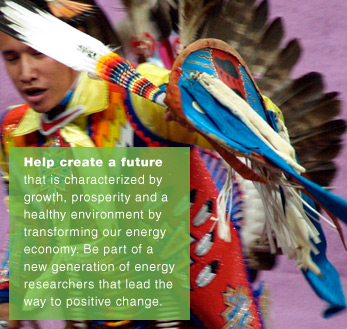

Vision
Create a community of scholars with the unique tools and insights needed to balance the technological, environmental, and social dimensions of a sustainable energy economy.
Program - Partners
PARTNER ORGANIZATIONS
- Yakama Nation Department of Natural Resources (YN-DNR): The Confederated Tribes and Bands of the Yakama Nation manage 1,200,000 acres, with 300,000 acres of commercial forest. For information about the Confederated Tribes and Bands of the Yakama nation see Yakama Nation Cultural Center.
- Confederated Tribes of the Colville Reservation. The Colville Indian Reservation spans 1.4 million acres of North Central Washington primarily in Okanogan and Ferry counties. It is bordered to the East by the Okanogan River and to the West and South by Lake Roosevelt and the Columbia River.
- Confederated Salish Kootenai Tribes. The Confederated Salish and Kootenai Tribes are comprised of the Bitterroot Salish, the Pend d’Oreille and the Kootenai tribes. The Flathead Reservation is comprised of 1.317 million acres in northwest Montana.
- All Nations Alliance for Minority Participation: The All Nations LSAMP focuses on increasing STEM degrees among Native Americans.
- Center for Innovation and Research in Graduate Education: CIRGE helps PhDs cross traditional boundaries between countries and employment sectors to work collaboratively in complex global communities.
- Center for Process Analytical Chemistry (CPAC): CPAC is an Industry-University Cooperative Research Center, focused on continuous real-time measurements are needed for industrial and environmental processes.
UW FACULTY PARTNERS
Faculty throughout the University and primarily in the Chemical Engineering Department, Mechanical Engineering Department, Materials Science and Engineering Department, College of Forest Resources, and the American Indian Studies Program are invited to participate in the BioResources IGERT program. The faculty involved in the program represent four teams:
MOLECULAR PROCESSING TEAM
- Dan Schwartz (Chemical Engineering): Microscale chemical processing
- Stuart Adler (Chemical Engineering): High temperature chemistry, fuel cells
- Renata Bura (Forest Resources): Bioprocessing of cellulosic biomass
- Rick Gustafson (Forest Resources): Wood processing science & technology
- Eric Stuve (Chemical Engineering): Surface science, energy
- Mary Lidstrom (Chemical Engineering): Genomic and metabolic manipulations of methylotrophic bacteria
SYSTEMS DESIGN & ENGINEERING TEAM
- Joyce Cooper (Mechanical Engineering): Life Cycle Assessment, sustainability, fuel cells
- Guozhong Cao (Material Science & Engineering): Nanomaterials for energy storage
- John Kramlich (Mechanical Engineering): Energy and fluids
RESOURCE MANAGEMENT TEAM
- Kristiina Vogt (Forest Resources): Ecosystem management, bioenergy
- Bob Edmonds (Forest Resources): Biology of forests
- Sharon Doty (Forest Resources): Forest biotechnology
- Monika Moskal (Forest Resources): Remote Sensing and Biospatial Analysis
- Tom Hinckley (Forest Resources): Forest and restoration ecology
- Jerry Franklin (Forest Resources): Forest and landscape ecology, ecosystems processes
- Dan Vogt (Forest Resources): Forest ecology, soils, systems and bioenergy
- John Perez Garcia (Forest Resources): Trade analysis and modeling of forest sector
AMERICAN INDIAN EDUCATION
- Tom Colonnese (American Indian Studies): American Indian Science and Technology Education

